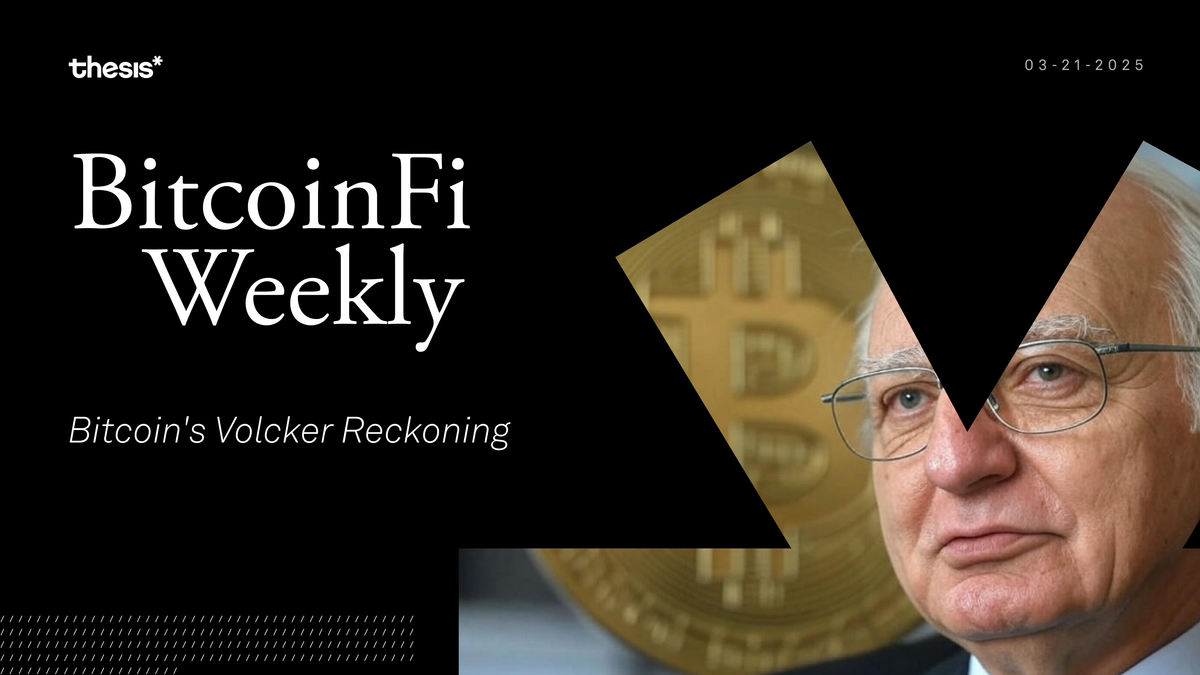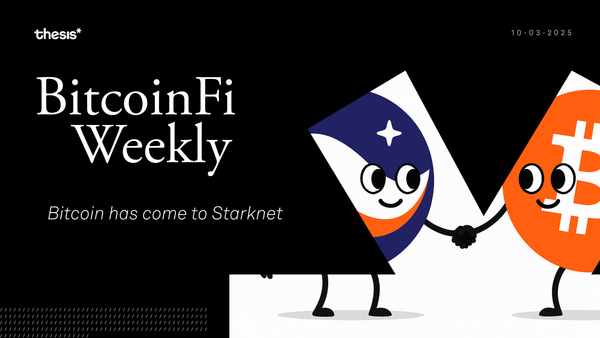Bitcoin's Volcker Reckoning
Bitcoin has become a mirror to the world's conscience, a relentless leading indicator, warning of dangers we ourselves have created yet still refuse to acknowledge. In watching Bitcoin tremble at each whisper of turmoil, we glimpse the truth Volcker once knew.

Welcome to BitcoinFi Weekly. We cover where people use their BTC and what is changing in the Bitcoin world.
Like the flickering lights in a shady motel room, the economic air is thick with uncertainty. Tariffs are rising, the economy stutters and whispers of recession hang in the shadows. This week's feature piece peers into these shadows, exploring echoes of Volcker’s stern medicine now remixed by Trump's unpredictability. All the while making Bitcoin twitch like a barometer in a storm. The numbers are dancing backward as GDP forecasts plummet, S&P loses trillion in value and Bitcoin slides from celestial heights. Strange world we're living in.
Here’s this week’s rundown:
📉 Feature Piece: Bitcoin's Volcker Reckoning
🌳 Bark Launches on Signet
🧙 Taproot Wizards Invests in Odin.Fun
📊 Bitcoin Suisse March TLDR
Feature Piece: Bitcoin's Volcker Reckoning
We're at what you might call a new Volcker moment, but with a Trump twist. What's happening with tariffs, inflation, and, consequently, Bitcoin has some interesting parallels to what Volcker did with interest rates back in the early 80s.In 1979, Paul Volcker stood before a skeptical nation and announced that the Federal Reserve would aggressively raise interest rates to combat runaway inflation. It was unpopular, risky, and painful. However, Volcker clearly saw what others would not: prudence requires stopping before disaster in markets, even if others are eager to keep pushing.
Today, a similar tension grips markets as investors chase assets amid unprecedented global debt and geopolitical chaos. This discomfort, this intuitive caution—the essence of "Volcker-ism"—is what Bitcoin investors must now reckon with. Volcker knew sometimes you need short-term suffering for long-term stability. Classic economic medicine.
Trump's approach shares that willingness for short-term pain, but his toolkit is completely different - slapping 25% tariffs on Canada and Mexico, plus another 10% on Chinese imports. Unlike Volcker, who strangled the money supply, Trump seems to create conditions that might force monetary expansion. It makes sense when you consider Trump's background. He's a real estate developer who understands leverage and cheap debt. His economic playbook has always been about engineering favorable borrowing conditions.
The economic data doesn't look good. The Atlanta Fed's GDPNow latest estimate for real GDP growth plummeted to -1.8% as of March 18th. Manufacturing indicators are weakening, and consumer spending is pulling back. We've seen a massive $4 trillion wipeout in the S&P 500 value since last month's peak. Bitcoin dropped from $105,000 to $80,000 before finding some support.
The market reaction to Trump's tariff announcement was immediate and instructive. When the tariffs were announced, Bitcoin started free-falling. This isn't coincidental. Bitcoin functions as the only truly global free market in existence and has historically been quick to react to changes in global liquidity conditions.
As mentioned earlier, Trump's approach diverges from Volcker in a fundamental way. Volcker fought inflation, but Trump's tariff policy could actually fuel it. University of Chicago economists found consumers expect prices on imports to increase 10% next year, with domestic goods up 14%. The Tax Foundation calculates these tariffs effectively create a $1,072 tax increase per household. Meanwhile, the DOGE initiative under Elon Musk is pushing government efficiency through workforce reduction. We're already seeing higher jobless claims in the D.C. area and falling housing prices. This represents a microcosm of the greater contractionary policy as well as a dangerous brew: inflationary tariffs paired with contractionary spending cuts - mixed signals that create an unusual and, more importantly, uncertain economic environment.
For Bitcoiners, here's what matters:
- If Trump's policies trigger a recession, the Fed will likely cut rates aggressively. Each 0.25% cut essentially creates about $100 billion in liquidity.
- Between rate cuts, ending QT, and potential QE, we could see $2.74-3.24 trillion of new liquidity - about 70-80% of COVID-era stimulus levels.
- Bitcoin tends to lead market movements both down and up. It showed weakness first and likely will lead when strength rears its face.
- Trump continues mentioning a strategic Bitcoin reserve and, in fact, put out an EO. Implementation remains questionable due to a number of interesting characters surrounding the White House “crypto council, but needless to say, it’s on their mind.
We all know Bitcoin has evolved into a bit of a global financial barometer. In light of this, I, for one, will be taking the venerable Arthur Hayes’ words to heart: Let politicians do politician things, stay in your lane, and buy Bitcoin.
BitcoinFi Updates
Bark Launches on Signet
Second has officially launched Bark, its Ark protocol implementation on Bitcoin’s signet test network. Ark is a Bitcoin Layer 2 protocol enabling fast, low-cost, and self-custodial payments, and distinctively introduces concepts like "sends" (payments), "refreshes" (liquidity management operations), "rounds" (batch processing cycles), and "expiry" (transaction validity windows). By integrating Ark with Lightning Network payments, developers can streamline user experiences with Bitcoin payments while preserving decentralization (a grain of salt, as this is on LN) and custody control. By running Bark, developers can build apps that easily support both Ark and Lightning payments simultaneously.
Taproot Wizards Invests in Odin.Fun
Taproot Wizards has announced a strategic investment in ODIN.FUN, a rapidly growing trading platform specializing in Bitcoin-based assets. ODIN.FUN offers a user-friendly environment where technicalities like bridging are abstracted away, providing seamless integration along with automated market makers and liquidity pools. Taproot Wizards’ decision was motivated by ODIN.FUN's impressive closed beta experience in January. Its simplicity, ease of use, and practicality address long-standing gaps in Bitcoin trading infrastructure. This investment comes as mindshare in memecoin trading has taken a step back, as VCs resume focus on infra projects and defi applications rather than other so-called “consumer dapps”.
Bitcoin Suisse March Report TLDR
Bitcoin Suisse's March 2025 report paints a picture of Bitcoin's evolving market position amid macroeconomic uncertainty. Despite experiencing a sharp 28% correction from January highs, Bitcoin has demonstrated remarkable resilience, maintaining a modest 0.2% YTD gain while establishing itself as an effective portfolio diversifier with consistently low cross-asset correlations averaging just 0.06. The market's structural foundation has fundamentally transformed, with nearly 14% of Bitcoin's supply now held by institutional investors and sovereign entities, significantly reducing available float and altering traditional volatility patterns.
This maturation is evident in the unprecedented two-year streak without a 30%+ drawdown, giving the impression that Bitcoin has entered a new era of stability driven by "stronger hands" in the market. Meanwhile, gold continues its strong performance as central banks diversify away from USD reserves, while altcoins struggle under regulatory constraints, capital dilution across millions of tokens, institutional Bitcoin preference, and tight monetary conditions. Looking forward, Bitcoin Suisse expects declining Bitcoin volatility and weakening DXY to be potential catalysts for significant upside once market uncertainties ease, particularly if recent presidential advocacy for a strategic crypto reserve shifts sentiment and triggers renewed institutional confidence.
Closing Thoughts
In the end, one feels compelled to see Volcker as more than just a banker; he could be likened to a prophet, a figure who understood deeply, perhaps tragically, that human suffering and redemption dance forever intertwined. Bitcoin, in its restless movements, seems to grasp this too, embodying the feverish soul of a market caught between hope and despair. It has become a mirror to the world's conscience, a relentless leading indicator, warning of dangers we ourselves have created yet still refuse to acknowledge. In watching Bitcoin tremble at each whisper of turmoil, we glimpse the truth Volcker once knew: the greatest risk lies not in seeing reality for what it is, but in closing our eyes and dreaming recklessly into oblivion.
Thank you for tuning in to this week’s BitcoinFi Weekly. See you next week.
If there's a topic you’d like us to cover or have questions, reach out at [email protected].





